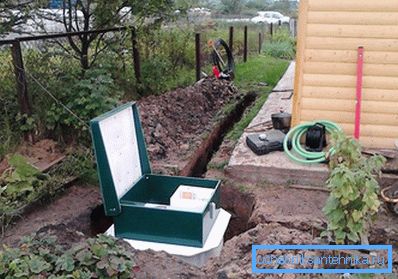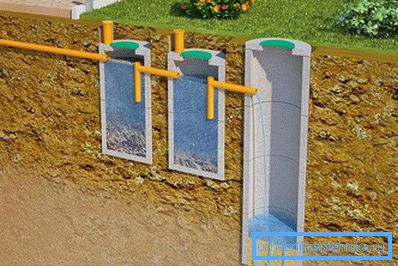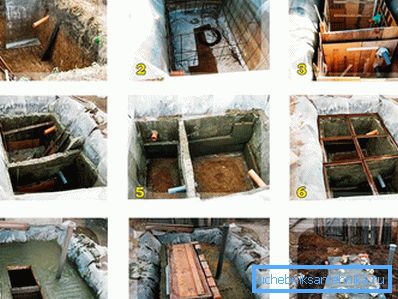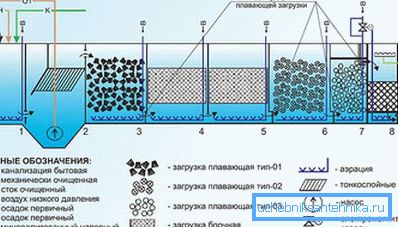Local sewage for a country house
Building a country house or equipping the dacha, you are sure to think about creating amenities. For this you need to connect to the central sewer system. But what if there is simply no one in the village? In this case, the local sewage system for a country house or cottage will help. And what are the options for such a system will be discussed in this article.
General principles of construction

If you settled in the country or purchased a dacha, then one of the first tasks will be the arrangement of the sewage system. After all, this will depend on the comfort of living.
Autonomous systems themselves are not much different from those connected to the central sewer. All the same plumbing fixtures. The main difference is where all impurities will be collected and cleaned.
For these purposes, you can use several options. Namely:
- cesspool - the cheapest option. The downside is that you must always monitor the level of accumulated stocks;
- sludge system. Cost is more expensive than the previous version, but significantly simplifies the process of operation;
- simple mechanical septic tank. Such devices do not collect drains, but clean them;
- biological treatment facilities. It is these devices that most effectively cope with their tasks, but at the same time they are the most expensive both in purchasing and in operation.

When designing an autonomous system, you can choose the appropriate option. The choice will depend on the installation site (if it happens in the country, then there is no point in installing expensive biological systems), on your financial capabilities and on the number of drains. To help you with the choice, we will sort each device separately.
Minimum expenses for arrangement

A simple option can be considered a cesspool. Such a device will solve the main tasks - disposal of sewage. Of course, the cesspool cannot cope with this function directly; it will serve as a mere collection of drains. After filling, it is necessary to call the cesspool machine and pump out the accumulated impurities. The most attractive in the use of cesspool is considered to be ease of execution. It is enough to dig a ditch and lay out its inner surface with a hermetic material. Such work will not take much time and will require a minimum of financial investments.
Tip! The operation of the sump will certainly cause inconvenience. First, the tank will fill up quickly. Secondly, the pumping of sewage itself is associated with financial costs.
Sludge systems

Considered to be more modern systems using settling tanks. As a matter of fact, in such a device a partial sewage treatment can already be done. The system itself will look like this:
- wastewater is discharged to the outside and into a septic tank, which is a sealed container. Here the solid fractions settle to the bottom. In addition, in the tank there is a partial decomposition of organic impurities under the influence of anaerobic bacteria;
- the filtered water from the sump falls into the drainage well. Its bottom is made of crushed stone. Leaking through such a filter, the drains are discharged into the ground.
Such a device is perfect for a small family or to give. With a small amount of waste they will have time to decompose. For this reason, it is rarely necessary to pump out accumulated impurities, which will significantly reduce the cost of operation.

Installation of such a system will not cause much difficulty. For arranging the sump and filter wells, you can use different materials. So, concrete rings are great, you can make a brickwork or pour concrete. Recently, special plastic containers have appeared that are conveniently used in the construction of such a system. Such products are sealed and durable.
Use of mechanical septic tanks

To create an autonomous sewer system, simple mechanical septic tanks are often used. Such designs are a multi-chamber capacity. In the first chambers there is a sedimentation and clarification of drains. Anaerobic bacteria that decompose organic compounds come into play.
The principle of operation of mechanical septic tanks is similar to the work of simple septic tanks. The solid particles settle to the bottom, where they accumulate and are subsequently pumped out by the assenizator service. The liquid component is cleaned by exposure to colonies of microorganisms. Subsequently, the purified water is poured onto the aeration fields or is passed through a stone filter.

If we talk about the advantages of such septic tanks, it is worth highlighting the following:
- low cost, as the device itself, and installation work;
- large selection of models. On sale you can find many options for mechanical septic tanks. Such devices are produced by various manufacturers, so it is easy to choose the right one for performance and price;
- non-volatility. Such septic tanks do not need electricity, because there are no pumps or compressors inside. All processes occur naturally. This means that the cost of operation is practically absent;
- simplicity of design does not require maintenance.
There are also disadvantages. First, the degree of sewage treatment rarely exceeds 90%. Therefore, it is imperative to use aeration fields or crushed stone filter. Secondly, it is necessary to pump the accumulated solid sediment at least once a year (depending on the model).
Tip! Such septic tanks are very sensitive to the sudden discharge of a large amount of wastewater. In this case, the degree of purification drops sharply.
We use biological treatment systems

Biological wastewater treatment systems are considered more advanced. They appeared relatively recently, but already managed to find their supporters. This treatment plant is produced in the factory and has a number of significant advantages compared with all previous options:
- the degree of wastewater treatment is close to 99%;
- the possibility of using purified water for irrigation or technical needs. For this reason, there is no need to frequently call an aspener machine. You will bear the cost of pumping out no more than once every 2-3 years;
- sludge formed during the operation of the system can be used as a fertilizer;
- compactness. All mechanisms are enclosed in a single hermetic case, which does not take up much space;
- the ability to cope with sudden discharges, without compromising the quality of cleaning;
- long service life (with proper care and compliance with recommendations on the composition of wastewater).

Disadvantages of biological treatment systems:
- need power supply. Inside the systems there are various pumps and compressors. These mechanisms are necessary to supply oxygen from the atmosphere that microorganisms need;
- quite high cost. Biological treatment plants are high-tech products. Therefore, their cost far exceeds the usual mechanical septic tanks.
But, despite the prices, it is these systems that are increasingly being installed in autonomous sewage systems. After all, they are able to quickly and efficiently clean the drains. Today in the market you can find different models. Among the most popular are Topas and Astra. They are produced in different configurations, each of which is designed for a certain amount of wastewater per day.